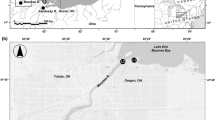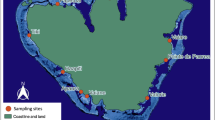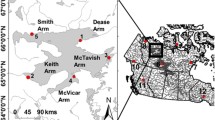Abstract
The cosmopolitan lamniform shark Carcharias taurus (commonly known as the ragged-tooth, grey nurse or sand tiger shark) is threatened by overexploitation in parts of its range. Return migrations of females to specific nursery areas suggest that females exhibit reproductive philopatry, a behaviour that over time might lead to genetically isolated subpopulations over various spatial scales. To investigate genetic evidence for reproductive philopatry, genetic data from mitochondrial and microsatellite markers were generated for 104 young-of-the-year and juvenile sharks. Comparing the smallest versus the largest young sharks revealed a pattern of size-related differentiation between nurseries that was only found in the smaller size class. This not only confirms reproductive philopatry of their mothers, but is also in line with previous observations of larger juvenile sharks increasing their migration range and moving between sites. Our results highlight the need to target young-of-the-year sharks when investigating reproductive philopatry to exclude roaming individuals that obscure size-related signals of genetic differentiation. Given the species’ high susceptibility to overexploitation, the evidence for reproductive philopatry is of direct importance to the management and conservation of C. taurus worldwide. As many nursery areas as possible should be protected to ensure that the number of locally resident juveniles and the pool of the returning females remain stable in the long term. This may warrant protected areas, or time-area closures, prohibiting exploitation in the nursery areas during pupping season.



Similar content being viewed by others
References
Ahonen H, Stow A (2009) Population size and structure of grey nurse shark in east and west Australia. Final Report to Department of Marine and Freshwater Environment, Water, Heritage and the Arts. Macquarie University, Sydney, Australia
Ahonen H, Harcourt RG, Stow AJ (2009) Nuclear and mitochondrial DNA reveals isolation of imperilled grey nurse shark populations (Carcharias taurus). Mol Ecol 18:4409–4421. https://doi.org/10.1111/j.1365-294X.2009.04377.x
Alexander A (2017) genetic_diversity_diffs v1.0.3. https://github.com/laninsky/genetic_diversity_diffs . Accessed 20 Feb 2018
Ashe JL, Feldheim KA, Fields AT, Reyier EA, Brooks EJ, O’Connell MT, Skomal G, Gruber SH, Chapman DD (2015) Local population structure and context-dependent isolation by distance in a large coastal shark. Mar Ecol Prog Ser 520:203–216. https://doi.org/10.3354/meps11069
Baum JK, Baum JK, Myers RA, Kehler DG, Worm B, Harley SJ, Doherty PA (2010) Collapse and conservation of shark populations in the Northwest Atlantic. Science 299:389–392. https://doi.org/10.1126/science.1079777
Benjamini Y, Yekutieli D (2001) The control of the false discovery rate in multiple testing under dependency. Ann Stat 29:1165–1188
Blower DC, Pandolfi JM, Bruce BD, Gomez-Cabrera MDC, Ovenden JR (2012) Population genetics of Australian white sharks reveals fine-scale spatial structure, transoceanic dispersal events and low effective population sizes. Mar Ecol Prog Ser 455:229–244. https://doi.org/10.3354/meps0965
Bonfil R, Meÿer M, Scholl MC, Johnson R, O’brien S, Oosthuizen H et al (2005) Transoceanic migration, spatial dynamics, and population linkages of white sharks. Science 310:100–103
Brothers JR, Lohmann KJ (2018) Evidence that magnetic navigation and geomagnetic imprinting shape spatial genetic variation in sea turtles. Curr Biol 28:1325–1329. https://doi.org/10.1016/j.cub.2018.03.022
Brown CA, Gruber SH (1988) Age assessment of the lemon shark, Negaprion brevirostris, using tetracycline validated vertebral centra. Copeia 3:747–753. https://doi.org/10.2307/1445397
Brownstein MJ, Carpten JD, Smith JR (1996) Modulation of non-templated nucleotide addition by TaqDNA Polymerase: primer modifications that facilitate genotyping. Biotechniques 20:1004–1010
Cadenat J (1956) Note d’ichtyologie ouest-africaine. XIV. Remarques biologiques sur le Requin-sable Carcharias (Odontaspis) taurus Rafinesque 1810. Bull Inst Fr Afr Noire 18:1249–1256
Chapman DD, Babcock EA, Gruber SH, Dibattista JD, Franks BR, Kessel SA, Guttridge T, Pikitch EK, Feldheim KA (2009) Long-term natal site-fidelity by immature lemon shark (Negaprion brevirostris) at a subtropical island. Mol Ecol 18:3500–3507. https://doi.org/10.1111/j.1365-294x.2009.04289.x.9
Chapman DD, Feldheim KA, Papastamatiou YP, Hueter RE (2015) There and back again: a review of residency and return migrations in sharks, with implications for population structure and management. Ann Rev Mar Sci 7:547–570
Chapuis MP, Estoup A (2007) Microsatellite null alleles and estimation of population differentiation. Mol Biol Evol 24:621–631. https://doi.org/10.1093/molbev/msl191
Chiaramonte G, Domingo A, Soto J (2007) Carcharias taurus (Southwest Atlantic subpopulation). IUCN Red List Threat Species 2007:e.T63163A12625032. https://doi.org/10.2305/IUCN.UK.2007.RLTS.T63163A12625032.en
Cliff G, Dudley SF (2011) Reducing the environmental impact of shark-control programs: a case study from KwaZulu-Natal, South Africa. Mar Freshw Res 62:700–709
Compagno LJ (2001) Sharks of the world: an annotated and illustrated catalogue of shark species known to date. Vol. 2: Bullhead, mackerel and carpetharks (Heterodontiformes, Lamniformes and Orectolobiformes. Food and Agriculture Organization of the United Nations, Rome
Daly-Engel TS, Seraphin KD, Holland KN, Coffey JP, Nance HA, Toonen RJ, Bowen BW (2012) Global phylogeography with mixed-marker analysis reveals male-mediated dispersal in the endangered scalloped hammerhead shark (Sphyrna lewini). PLoS One 7:e29986. https://doi.org/10.1371/journal.pone.0029986
Davidson LNK, Krawchuk MA, Dulvy NK (2016) Why have global shark and ray landings declined: improved management or overfishing? Fish Fish 17:438–458. https://doi.org/10.1111/faf.12119
DiBattista JD, Feldheim KA, Thibert-Plante X, Gruber SH, Hendry AP (2008) A genetic assessment of polyandry and breeding-site fidelity in lemon sharks. Mol Ecol 17:3337–3351. https://doi.org/10.1111/j.1365-294X.2008.03833.x
Dicken ML, Smale MJ, Booth AJ (2006) Spatial and seasonal distribution patterns of the ragged-tooth shark Carcharias taurus along the coast of South Africa. Afr J Mar Sci 28:603–616. https://doi.org/10.2989/18142320609504210
Dicken ML, Booth A, Smale M, Cliff G (2007) Spatial and seasonal distribution patterns of juvenile and adult raggedtooth sharks (Carcharias taurus) tagged off the east coast of South Africa. Mar Freshw Res 58:127. https://doi.org/10.1071/MF06018
Dicken ML, Booth A, Smale M (2008) Estimates of juvenile and adult raggedtooth shark (Carcharias taurus) abundance along the east coast of South Africa. Can J Fish Aquat Sci 65:621–632. https://doi.org/10.1139/f07-190
Dicken ML, Smale MJ, Booth AJ (2012) Long-term catch and effort trends in Eastern Cape Angling Week competitions. Afr J Mar Sci 34:259–268. https://doi.org/10.2989/1814232X.2012.709961
Dudley SFJ, Simpfendorfer CA (2006) Population status of 14 shark species caught in the protective gillnets off KwaZulu-Natal beaches, South Africa, 1978–2003. Mar Freshw Res 57:225–240. https://doi.org/10.1071/MF05156
Excoffier L, Lischer H (2010) Arlequin suite ver 3.5: a new series of programs to perform population genetics analyses under Linux and Windows. Mol Ecol Resour 10:564–567
Excoffier L, Smouse PE, Quattro JM (1992) Analysis of molecular variance inferred from metric distances among DNA haplotypes: application to human mitochondrial DNA restriction data. Genetics 131:479–491
Feldheim KA, Gruber SH, Ashley MV (2002) The breeding biology of lemon sharks at a tropical nursery lagoon. Proc R Soc B 269:1655–1661. https://doi.org/10.1098/rspb.2002.2051
Feldheim KA, Gruber SH, DiBattista JD, Babcock EA, Kessel ST, Hendry AP, Pikitch EK, Ashley MV, Chapman DD (2014) Two decades of genetic profiling yields first evidence of natal philopatry and long-term fidelity to parturition sites in sharks. Mol Ecol 23:110–117. https://doi.org/10.1111/mec.12583
Feutry P, Kyne PM, Pillans RD, Chen X, Marthick JR, Morgan DL, Grewe PM (2015) Whole mitogenome sequencing refines population structure of the Critically Endangered sawfish Pristis pristis. Mar Ecol Prog Ser 533:237–244. https://doi.org/10.3354/meps11354
Gilmore RG, Dodrill JW, Linley PA (1983) Reproduction and embryonic development of the sand tiger shark, Odontaspis taurus (Rafinesque). Fish Bull 81:201–225
Goldman KJ (2002) Aspects of age, growth, demographics and thermal biology of two lamniform shark species. Dissertation, College of William and Mary, Virginia Institute of Marine Science
Goldman KJ, Branstetter S, Musick JA (2006) A re-examination of the age and growth of sand tiger sharks, Carcharias taurus, in the western North Atlantic: the importance of ageing protocols and use of multiple back-calculation techniques. Environ Biol Fish 77:241–252. https://doi.org/10.1007/s10641-006-9128-y
Graves JE (1998) Molecular insights into the population structures of cosmopolitan marine fishes. J Hered 89:427–437
Hardy OJ (2003) Estimation of pairwise relatedness between individuals and characterization of isolation-by-distance processes using dominant genetic markers. Mol Ecol 12:1577–1588. https://doi.org/10.1046/j.1365-294X.2003.01835.x
Hasegawa M, Kishino H, Yano TA (1985) Dating of the human-ape splitting by a molecular clock of mitochondrial DNA. J Mol Evol 22:160–174. https://doi.org/10.1007/BF02101694
Heist E (2004) Genetics of shark, skate and rays. In: Carrier J, Musick J, Heithaus M (eds) Biology of sharks and their relatives. CRC, Boca Raton, pp 471–486
Heupel MR, Carlson JK, Simpfendorfer CA (2007) Shark nursery areas: concepts, definition, characterization and assumptions. Mar Ecol Prog Ser 337:287–297. https://doi.org/10.3354/meps337287
Howey-Jordan LA, Brooks EJ, Abercrombie DL, Jordan LKB, Brooks A, Williams S, Gospodarczyk E, Chapman DD (2013) Complex movements, philopatry and expanded depth range of a severely threatened pelagic shark, the oceanic whitetip (Carcharhinus longimanus) in the Western North Atlantic. PLoS One 8:e56588. https://doi.org/10.1371/journal.pone.0056588
Hueter R, Heupel M (2005) Evidence of philopatry in sharks and implications for the management of shark fisheries. J Northw Atl Fish Sci 35:239–247
Hutchings JA, Myers RA, García VB, Lucifora LO, Kuparinen A (2014) Life-history correlates of extinction risk and recovery potential. Ecol Appl 22:1061–1067. https://doi.org/10.1890/14-0468.1
Jombart T (2008) adegenet: a R package for the multivariate analysis of genetic markers. Bioinformatics 24:1403–1405
Jombart T, Devillard S, Balloux F (2010) Discriminant analysis of principal components: a new method for the analysis of genetically structured populations. BMC Genet 11:94
Kalinowski S (2005) Hp-rare 1.0: a computer program for performing rarefaction on measures of allelic richness. Mol Ecol Notes 5:187–189
Keenan K, McGinnity P, Cross TF, Crozier WW, Prodöhl PA (2013) diveRsity: an R package for the estimation and exploration of population genetics parameters and their associated errors. Methods Ecol Evol 4:782–788
Keeney DB, Heupel MR, Hueter RE, Heist EJ (2005) Microsatellite and mitochondrial DNA analyses of the genetic structure of blacktip shark (Carcharhinus limbatus) nurseries in the northwestern Atlantic, Gulf of Mexico, and Caribbean Sea. Mol Ecol 14:1911–1923. https://doi.org/10.1111/j.1365-294X.2005.02549.x
Kneebone J, Chisholm J, Skomal G (2014) Movement patterns of juvenile sand tigers (Carcharias taurus) along the east coast of the USA. Mar Biol 161:1149–1163. https://doi.org/10.1007/s00227-014-2407-9
Kumar S, Stecher G, Tamura K (2016) MEGA7: molecular evolutionary genetics analysis version 7.0 for bigger datasets. Mol Biol Evol 33:870–1874
Lohmann KJ, Putman NF, Lohmann CMF (2008) Geomagnetic imprinting: a unifying hypothesis of long-distance natal homing in salmon and sea turtles. Proc Natl Acad Sci USA 105:19096–19101. https://doi.org/10.1073/pnas.0801859105
Lucifora L, Menni RC, Escalante AH (2002) Reproductive ecology and abundance of the sand tiger shark, Carcharias taurus, from the southwestern Atlantic. ICES J Mar Sci 59:553–561. https://doi.org/10.1006/jmsc.2002.1183
Meirmans PG (2006) Using the AMOVA framework to estimate a standardized genetic differentiation measure. Evolution 60:2399–2402. https://doi.org/10.1554/05-631.1
Mourier J, Planes S (2013) Direct genetic evidence for reproductive philopatry and associated fine-scale migrations in female blacktip reef sharks (Carcharhinus melanopterus) in French Polynesia. Mol Ecol 22:201–214. https://doi.org/10.1111/mec.12103
Musick JA (1999) Ecology and conservation of long-lived marine animals. Am Fish Soc Symp 23:1–10
Nei M (1987) Molecular evolutionary genetics. Columbia University Press, New York
Otway NM, Ellis MT (2011) Pop-up archival satellite tagging of Carcharias taurus: movements and depth/temperature-related use of south-eastern Australian waters. Mar Freshw Res 62:607–620. https://doi.org/10.1071/MF10139
Peakall R, Smouse PE (2012) GenALEx 6.5: genetic analysis in Excel. Population genetic software for teaching and research-an update. Bioinformatics 28:2537–2539. https://doi.org/10.1093/bioinformatics/bts460
Pollard D, Smith A (2009) Carcharias taurus. IUCN Red List Threat Species 2009:e.T3854A10132481. https://doi.org/10.2305/IUCN.UK.2009-2.RLTS.T3854A10132481.en
Pollard D, Gordo I, Williams S, Flaherty A, McAuley R (2003) Carcharias taurus (East coast of Australia subpopulation). IUCN Red List Threat Species 2003:e.T44070A10854830. https://doi.org/10.2305/IUCN.UK.2003.RLTS.T44070A10854830.en
Portnoy DS, McDowell JR, Heist EJ, Musick JA, Graves JE (2010) World phylogeography and male-mediated gene flow in the sandbar shark, Carcharhinus plumbeus. Mol Ecol 19:1994–2010. https://doi.org/10.1111/j.1365-294X.2010.04626.x
Putman NF, Lohmann KJ, Putman EM, Quinn TP, Klimley AP, Noakes DLG (2013) Evidence for geomagnetic imprinting as a homing mechanism in pacific salmon. Curr Biol 23:312–316. https://doi.org/10.1016/j.cub.2012.12.041
Raymond M, Rousset F (1995) GENEPOP (version 1.2): population genetics software for exact tests and ecumenicism. J Hered 86:248–249
Rousset F (2008) A complete re-implementation of the genepop software for Windows and Linux. Mol Ecol Resour 8:103–106
RSA (Republic of South Africa) (1998) Marine living resources act (act no. 18 of 1998). Gov Gaz 395:1–67
Salzburger W, Ewing GB, Von Haeseler A (2011) The performance of phylogenetic algorithms in estimating haplotype genealogies with migration. Mol Ecol 20:1952–1963
Sandoval-Castillo J, Beheregaray LB (2015) Metapopulation structure informs conservation management in a heavily exploited coastal shark (Mustelus henlei). Mar Ecol Prog Ser 533:191–203
Schuelke M (2000) An economic method for the fluorescent labeling of PCR fragments. Nat Biotechnol 18:233–234. https://doi.org/10.1038/72708
Schwarz G (1978) Estimating the dimension of a model. Ann Stat 6:461–464. https://doi.org/10.1214/aos/1176344136
Smale M, Dicken ML, Booth A (2015) Seasonality, behaviour and philopatry of spotted ragged-tooth sharks Carcharias taurus in Eastern Cape nursery areas, South Africa. Afr J Mar Sci 37:219–231. https://doi.org/10.2989/1814232X.2015.1043342
Tajima F (1983) Evolutionary relationship of DNA sequences in finite populations. Genetics 105:437–460 (doi:6628982)
Tamura K, Nei M (1993) Estimation of the number of nucleotide substitutions in the control region of mitochondrial DNA in humans and chimpanzees. Mol Biol Evol 10:512–526
Taniuchi T (1970) Variation in the teeth of the sand tiger shark, Odontaspis taurus (Rafinesque) taken from the East China Sea. Jpn J Ichthyol 17:37–44
Teter SM, Wetherbee BM, Fox DA, Lam CH, Kiefer DA, Shivji M (2015) Migratory patterns and habitat use of the sand tiger shark (Carcharias taurus) in the western North Atlantic. Mar Freshw Res 66:158–169. https://doi.org/10.1071/MF14129
Thompson JD, Higgins DG, Gibson TJ (1994) CLUSTAL W: improving the sensitivity of progressive multiple sequence alignment through sequence weighting, position-specific gap penalties and weight matrix choice. Nucleic Acids Res 22:4673–4680
Tillett BJ, Meekan MG, Field IC, Thorburn DC, Ovenden JR (2012) Evidence for reproductive philopatry in the bull shark Carcharhinus leucas. J Fish Biol 80:2140–2158. https://doi.org/10.1111/j.1095-8649.2012.03228.x
Van Oosterhout C, Hutchinson WF, Wills DPM, Shipley P (2004) MICRO-CHECKER: software for identifying and correcting genotyping errors in microsatellite data. Mol Ecol Notes 4:535–538. https://doi.org/10.1111/j.1471-8286.2004.00684.x
Walker TI (1998) Can shark resources be harvested sustainably? A question revisited with a review of shark fisheries. Mar Freshw Res 49:553–572
Walls R, Soldo A (2016) Carcharias taurus. IUCN 2016:e.T3854A16527817
Ward-Paige CA, Keith DM, Worm B, Lotze HK (2012) Recovery potential and conservation options for elasmobranchs. J Fish Biol 80:1844–1869. https://doi.org/10.1111/j.1095-8649.2012.03246.x
Weinberg W (1908) On the demonstration of heredity in man. In: Boyer SH (ed) (1963) Papers on human genetics. Prentice Hall, Englewood Cliffs
Wright S (1943) Isolation by distance. Genetics 28:114–138
Wright S (1949) The genetical structure of populations. Ann Hum Genet 15:323–354
Ye J, Colouris G, Zaretskaya I, Cutcutache I, Rozen S, Madden TL (2012) Primer-BLAST:tool to design target-specific primers for polymerase chain reaction. BMC Bioinform 13:134
Acknowledgements
Special thanks are given to all volunteer anglers that collected samples as part of the Port Elizabeth Museum (PEM) co-operative shark tagging programme. We also thank the PEM Director and staff for their support and infrastructure. We would also like to thank two anonymous reviewers whose constructive comments improved the final version of this manuscript.
Funding
This work is based on research supported in part by the National Research Foundation of South Africa through a Thuthuka grant to KLM (Unique Grant no. 99440) and the University of Johannesburg (FRC/URC Grant to PRT). JDK is grateful to the University of Johannesburg for awarding her a Global Excellence and Stature (GES) PhD bursary.
Author information
Authors and Affiliations
Corresponding author
Ethics declarations
Conflict of interest
The authors have no conflict of interest to declare.
Ethical approval
All capture and sampling protocols were conducted following guidelines endorsed by the PEMs animal ethics committee.
Additional information
Responsible Editor: O. Puebla.
Publisher's Note
Springer Nature remains neutral with regard to jurisdictional claims in published maps and institutional affiliations.
Reviewed by Undisclosed experts.
Electronic supplementary material
Below is the link to the electronic supplementary material.
Rights and permissions
About this article
Cite this article
Klein, J.D., Bester-van der Merwe, A.E., Dicken, M.L. et al. Reproductive philopatry in a coastal shark drives age-related population structure. Mar Biol 166, 26 (2019). https://doi.org/10.1007/s00227-019-3467-7
Received:
Accepted:
Published:
DOI: https://doi.org/10.1007/s00227-019-3467-7




